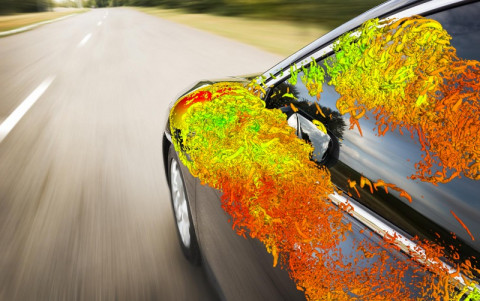ESI Group Announces VA One 2016
Paris, France – September 19, 2016 – ESI Group, a leading innovator in Virtual Prototyping software and services for manufacturing industries, announces the release of VA One 2016. VA One is the only full-frequency, single-environment simulation software available for solving a wide range of noise and vibration design challenges in automotive, aerospace, marine and industrial applications. VA One seamlessly combines Finite Elements, Boundary Elements and Statistical Energy Analysis into one flexible modeling environment.

Fluctuating surface pressures on the side glass of the car calculated using OpenFOAM® open source CFD code. Complex, fluctuating surface pressure data can be imported into VA One from nearly any commercial CFD code.
ESI VA One 2016 optimizes ongoing improvements in multi-core processing to provide significant improvements in overall model run time and overall performance speed, particularly in read, write, and solve steps. It also introduces unique capabilities for flexibly modeling complex loads and is able to robustly address the growing challenge faced by the automotive and aerospace industries to accurately predict wind and other noise due to turbulent flow effects. Excessive wind noise, which is generated by vehicles moving at high speed, is more than simply an acoustic annoyance to end users: excessive wind noise negatively impacts phone calls and applications using voice recognition inside the vehicle. Reducing wind noise as much as possible is thus crucial to allow optimal performance of various in-car communications.
Key highlights of VA One 2016:
Unique Enhancement Provides the Ability to Accurately Apply Complex Aero-Vibro-Acoustic (AVA) Loads to SEA (Statistical Energy Analysis) Models
Until now, SEA models excited by turbulent flow, or other partially correlated sources, were restricted to fitting analytical models; with consequent loss of important details of the loading. This left users the choice of accepting a loss of acoustic prediction accuracy or moving to more costly modeling approaches. The General Surface Pressure (GSP) enhancement in VA One 2016 removes this roadblock by allowing acoustic modelers to directly apply wavenumber spectra to SEA models. Taking advantage of the pre-processing capabilities of VA One, users can define the loads directly from CFD data or from their in house tools. Accurate design solutions can be obtained with minimal modeling and computational time.
Enhanced Acoustic Predictive Capabilities for FE Models with Complex Flow
Addressing another important noise source, VA One 2016 provides enhanced non-uniform acoustic FE mean flow predictive capabilities to accurately model the effect of flow on muffler Transmission Loss (TL) via automated OpenFOAM® analysis for reactive mufflers or when porous, sound absorbing muffler materials such as fiberglass are present. The greater the muffler Transmission Loss is, the quieter the muffler and exhaust. The challenge is to model the complex, three-dimensional airflow in mufflers. This is addressed by VA One 2016 by providing a high-level, automated solution for taking into account the flow effect on muffler acoustics when complex geometries, perforated elements or porous materials are present.
Performance and Productivity Enhancements
VA One 2016 delivers a wide array of overall performance and speed improvements that specifically address the aerospace, automotive, marine and industrial markets. Improvements specifically address multi-core BEM (Boundary Element Method) calculations and customers in automotive and related industrial markets will benefit from the new BEM improvements in Radiated Noise Calculations for modeling exterior noise generated, for example, by vehicle powertrains, consumer electronics, and industrial generators. Speed increases up to a factor of fifty have been achieved in certain complex BEM multi-core calculations. This enhancement in calculation speed has also been particularly welcomed by the aerospace industry where users seek ongoing performance improvements to BEM modeling and support for calculation-intense stress failure predictions.
Aerospace and marine customers will benefit from improved SEA modelling of ribbed panels, such as used in lower hull sections for marine applications in the fuselages of aircraft.
Customers have asked us for support in solving larger models, especially Boundary Element Models, which require a long time to compute, particularly for higher frequencies. These new enhancements to VA One take advantage of multi-core processing on individual machines as well as distributed machines (clusters) and provide significant improvements in overall model run time"
said Chad Musser, Director of Vibro-Acoustics Solution at ESI Group.
With the 2016 release of VA One, ESI delivers important enhancements that give our customers a competitive cost and time advantage in bringing innovative products to market. Our ability to consistently translate customer needs into software enhancements underscores ESI’s position as the industry leader in vibro-acoustic simulation", he added.
For more information about ESI VA One, please visit www.esi-group.com/products/va-one
Join ESI’s customer portal myESI to get continuously updated product information, tips & tricks, view the online training schedule and access selected software downloads: https://myesi.esi-group.com
For more ESI news, visit: www.esi-group.com/company/news